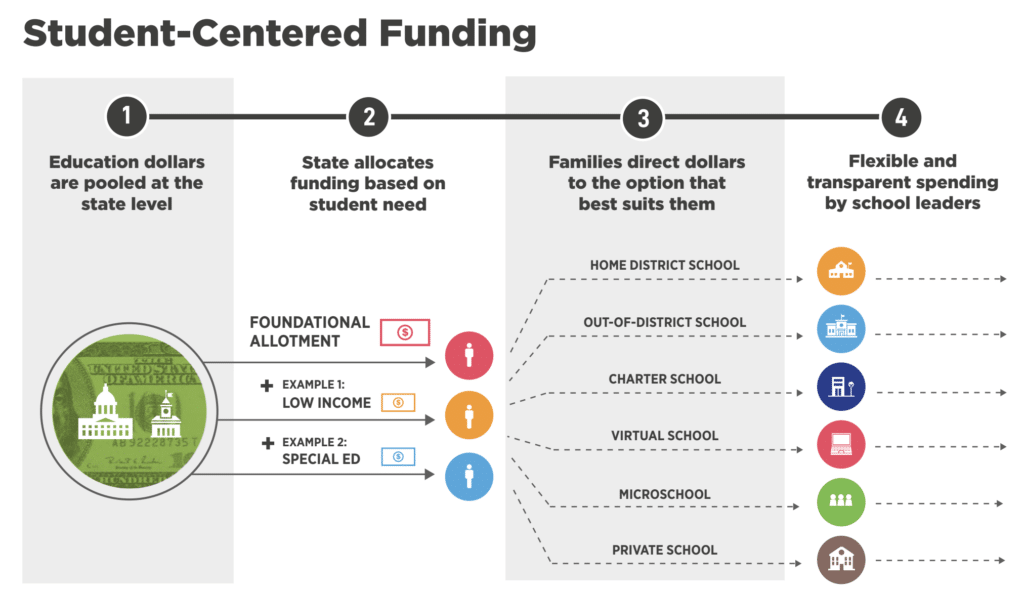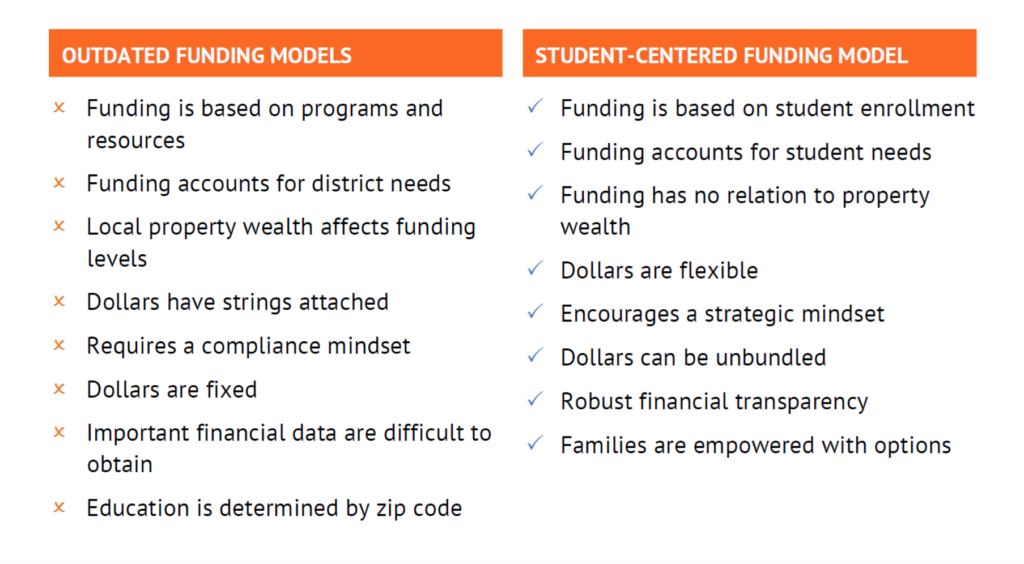Student-centered funding is an approach to K-12 education finance that ties education funding to individual students. Unlike other school finance approaches, student-centered funding puts student needs as the focus of education funding decisions.
Student-centered funding can take many forms but typically sets a base funding amount for regular-program students, with additional weights added for classifications such as English language learners, special education, and poverty. Under this system, a student would generate the same level of funding regardless of geographic location or what type of school they attend. Student-centered funding is based on four principles:
Fairness: Education dollars should be allocated based on the needs of individual students.
Transparency: School finance formulas should be streamlined and easy for parents, teachers, and school administrators to understand.
Portability: Education funding should not be tethered to a student’s zip code and should follow the child to the school of their choice.
Flexibility: Education leaders who are closest to kids are in the best position to decide how education dollars are spent.
The ideal student-centered funding system would follow a path like this:

Student-centered funding models account for student needs through weights, are based on up-to-date student enrollment numbers, and are not heavily tied to property wealth.
In many states, relying on local property tax revenue to determine student funding causes serious disparities across school districts. Not only does this put kids on uneven playing fields, but it can also make it difficult to implement open enrollment programs that give families options across school district boundaries.
The below chart highlights key differences between outdated education funding models and student-centered funding.

Yes, student-centered funding is often referred to as weighted-student funding, student-based budgeting, or fair student funding.
Student-based budgeting also refers to district-level funding reforms that district administrators can adopt to increase funding fairness, transparency, and flexibility. Student-based budgeting systems can empower school principals and other school leaders to make localized decisions for their students.
No school finance system is perfect, but 39 states employ some form of student-centered funding.
In 2013, California’s Local Control Funding Formula (LCFF) streamlined more than 30 categorical grants into a single weighted-student formula. A study by Education Trust-West found that this change helped drive substantial improvements in equity. LCFF remains a popular reform—in a survey of superintendents, 82 percent agreed that it is leading to greater alignment among goals, strategies, and resource allocation decisions, and 74 percent indicated that the financial flexibility enabled their district to match spending with local needs. A separate survey found that, of those familiar with the law, 72 percent of likely voters and 84 percent of parents viewed it positively.
Hawaii implemented a student-centered funding plan in the 2006-07 school year. The state continues to fine-tune its weighted-student formula in response to school leaders, community stakeholder concerns and other issues as they arise. However, since its introduction, the weighted-student formula has provided a much more equitable, needs-responsive, and transparent way to fund Hawaiian schools while boosting community engagement in key decisions about their local schools.
Most recently, Tennessee passed a law to use a new student-centered funding formula to fund school districts in the state. Before the reform was signed into law in the spring of 2022, Tennessee was one of only nine states that still employed a resource-based formula for allocating education dollars to school districts. This approach put the focus squarely on inputs such as staffing ratios rather than students’ needs and was mired in layers of complexity that reduced transparency.
Policymakers should keep in mind that there isn’t a one-size-fits-all solution to school finance, and weighted-student formulas should be based on the unique needs of a state’s students.
Open enrollment policies allow students to enroll in public schools outside of their residentially-assigned school building or school district. These policies provide school choice within public school systems and student-centered funding supports robust open enrollment.
In fact, for open enrollment policies to work effectively schools must be fairly compensated for accepting transfer students. Research from California’s public schools shows it’s critical to get the financial incentives right in order for school districts to accept transfer students. Student-centered funding models that attach education dollars to students are one way to ensure this happens.
Student-centered funding not only ensures education dollars are getting to the students that need them most, but it also makes it easier for states to offer families diverse education options outside of the traditional public school system.
Across the United States, public education systems are increasingly becoming untethered to zip codes via policies like charter schools, public school open enrollment, private school choice, and innovative learning methods like micro-schools. As student populations become more mobile and choose to attend a school outside of their residentially-assigned public school district, it will be crucial for states to make student-centered funding reforms.
Reason Foundation’s Christian Barnard outlined how this problem is impacting Arizona:
“This school-finance system is causing a number of issues for students and schools because it hasn’t been updated to reflect today’s choices, including charter schools, or modernized to the funding system needed when kids choose a school other than their assigned neighborhood school. First, there’s the funding gap between charter schools and district schools. Because district schools have access to various local property tax sources for facilities and daily school operations that charter schools do not, the average charter-school student receives $1,308 less in funding than the average district-school student. In a state where the Arizona Charter Schools Association finds more than one in five students now attend a charter school, this inequity is a major problem.”
States use weights to deliver extra funding to support certain student populations. The most frequently used weights are for low-income students, English language learners, and special education students.
Oftentimes, resource-based funding formulas can restrict district flexibility over spending decisions, which can lead to greater inefficiency. This can lead to insufficient services and poor student outcomes for not just higher-need students, but all students in a school district.
To help students and families, state policymakers should pursue four policy goals to fully adopt student-centered funding. These goals can be adopted separately over time or as a part of a comprehensive funding overhaul.
1. Streamline: Allocate education dollars based on students’ needs using a weighted student formula.
2. Equalize: Determine funding levels based on students, not by property wealth or zip code.
3. Empower: Deliver flexible education dollars and give families options outside of their residentially-assigned public schools.
4. Inform: Show parents and taxpayers how education dollars are allocated and spent.
Want more information on how your state can implement a student-centered funding formula?
Check out our Student-Centered Funding Roadmap for Policymakers here.

